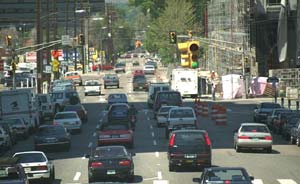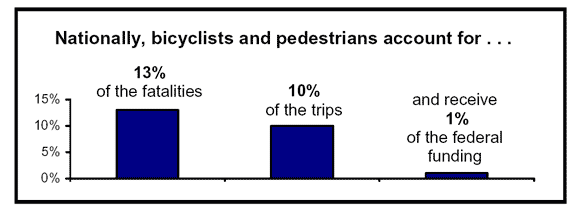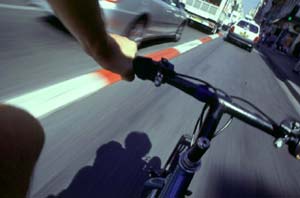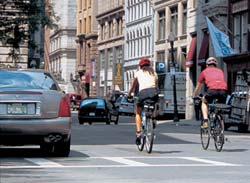What It Means To Complete The Streets
|
Think about the roads and streets where you live and work. What do they look like? Do they have two lanes? Four? Maybe even eight?
And, sadly, states are not building roads as complete transportation corridors. Only one percent of all federal transportation funding goes to bicycle or pedestrian facilities. In 2000, the U.S. DOT issued guidance saying “bicycling and walking facilities will be incorporated into all transportation projects unless exceptional circumstances exist.” |
| This article is used with permission from America Bikes.
For more information, contact: Martha Roskowski, Campaign Manager, America Bikes, |
Footnotes 1. Bureau of Transportation Statistics, 2002 National Survey of Pedestrian and Bicyclist Attitudes and Behaviors. 2. 2001 National Household Travel Survey; Fatality Analysis Reporting System 3. Pucher, J, (2003) Promoting Safe Walking and Cycling to Improve Public Health: Lessons from the Netherlands and Germany. American Journal of Public Health 93, 1509-1516. 4. Wilkinson, B., Chauncey, B. (2003) Are We There Yet? Assessing the Performance of State Departments of Transportation on Accommodating Bicycles and Pedestrians.” National Center for Bicycling and Walking. 5. Highway Statistics, 2001 6. King, MR, Carnegie, JA, Ewing, R. (2003) Pedestrian Safety Through a Raised Median and Redesigned Intersections, Transportation Research Board 1828 pp 56-66 7. Jacobsen, PL (2003). Safety in numbers: More walkers and bicyclists, safer walking and biking. Injury Prevention 9, 205-209. 8. Macbeth, A.G. (1999) Bicycle Lanes in Toronto ITE Journal 38-46. 9. Giles-Corti, B., & Donovan, R.J. (2002). The relative influence of individual, social, and physical environment determinants of physical activity. Social Science & Medicine, 54 1793-1812. 10. Bicycling in Portland Census Track Presentation to Portland City Council. 11. Clarke, A. National Household Transportation Survey, original analysis. 12. Belden, Russonello & Stewart, 2003 |



 Complete streets improve safety. They reduce crashes through safety improvements. One study found that designing for pedestrian travel by installing raised medians and redesigning intersections and sidewalks reduced pedestrian risk by 28%.
Complete streets improve safety. They reduce crashes through safety improvements. One study found that designing for pedestrian travel by installing raised medians and redesigning intersections and sidewalks reduced pedestrian risk by 28%.  With your help, Complete Streets can become a reality. While this campaign is still in the developmental phase a small amount of effort will help transform an abstract concept into a commonly accepted part of our culture.
With your help, Complete Streets can become a reality. While this campaign is still in the developmental phase a small amount of effort will help transform an abstract concept into a commonly accepted part of our culture.